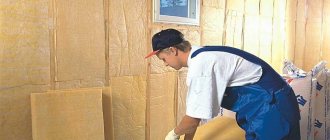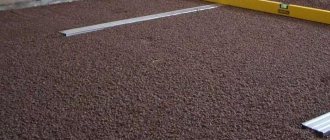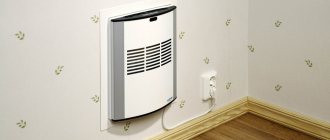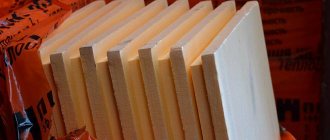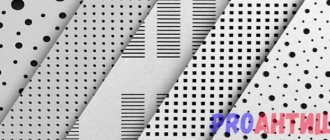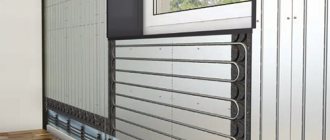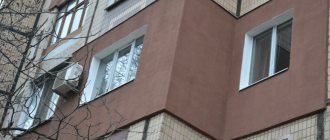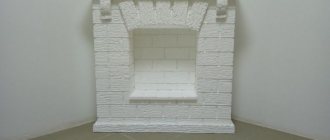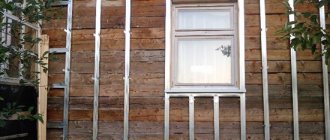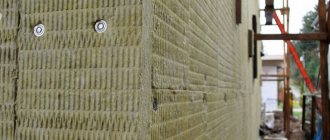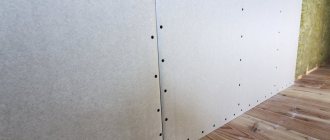The comfort and even the health of the residents depends on what kind of sound insulation is made in the apartment. Conventional fences in residential buildings do not provide complete protection of homes from noise coming from the street and from neighboring apartments.
The only solution to the problem is reliable protection from noise of walls, floors, partitions and ceilings. The photo below shows how a frame with heat and sound insulation is installed under drywall.
Insulation and soundproofing of walls in the house
Types of noise and influencing factors
Before making noise insulation, you should first understand the types of sound interference and how to protect against them.
The types of noise are as follows:
- impact - formed from mechanical impact on a building structure: the clicking of heels, objects falling to the floor, children jumping, etc.;
- structural – periodic mechanical impacts on the building structure and the spread of vibration throughout the building: operation of power tools, rearrangement of furniture, etc.;
- air - transmission of sound waves through the air from the street, from neighboring apartments from working audio, television equipment, spoken language, etc.
Before you fight the spread of sound and its entry into the apartment, you need to know how it is transmitted.
Sound waves travel in two ways:
- direct – sound transmission through windows or adjacent surfaces;
- indirect - passing through the supporting structures of the building, communications, holes and cracks.
The following factors influence the propagation of sound:
- doors and windows lack seals;
- building materials have poor sound insulation properties;
- voids, gaps and cracks in structures have the property of resonance;
- low-quality finishing materials.
Methods for installing sound insulation
Modern technologies have made it possible to use several types of sound insulation installation in residential premises:
| Type | Description |
| Absorption | The walls can be hollow and there will be air inside, which contributes to the increased spread of vibrations. The transmission principle is similar to drums. The problem can be solved using soundproofing materials. In addition to sound insulation, they contribute to the creation of a thermal effect (sound energy is converted into thermal energy). The degree of absorption will directly depend on the thickness of the material. |
| Denouement | The method is recognized as effective both in major repairs and construction. It is based on the principle of transmitting sound or vibration through a structure. Wall panels, partitions and various fasteners that are used during the construction process can prevent such spread. Vibration decoupling will be needed if a set of studs has been applied to two adjacent panels. Subsequent manipulations will be somewhat complicated by the need to dismantle old partitions, ceilings and floors. This method is used extremely rarely, as it requires the involvement of specialists. |
When installing waterproofing, thermal insulation of the ceiling and external ceilings, the soundproofing effect will also be achieved:
- Attenuation. Recognized as the most effective method that can be carried out independently. When vibration-isolating and sound-absorbing components are connected, a kind of barrier is created that helps convert sound energy into heat. This way, low-frequency sounds through thin walls can be limited. Their nature is structural - construction equipment, power tools and impacts.
- Increasing the mass of walls. It is based on the principle that the final indicator (result) depends on the density of the raw materials used. High-quality components will have a lot of weight and thickness. The most effective in relation to airborne noise, the nature of which has nothing to do with structural.
What to deal with: noise or sounds
Many people consider sound insulation and noise reduction to be synonymous, but this is not true. There are differences between them. Soundproofing walls, floors and ceilings involves changing the spectrum of unwanted sounds to such a level that the audible meaningful components become inaudible.
Even at the same intensity, an indistinct sound causes less irritation, and with prolonged exposure does not cause harm to a person.
Noise insulation consists of the general suppression of extraneous sounds. The background noise remains, but is not perceived psychophysiologically. Even sharp sounds do not cross the threshold of comfort. You can hear them, but they are not annoying.
Complete silence is not necessary for a person and is even harmful. There should always be some background noise.
Sound insulation index and sound absorption coefficient
Protective equipment can reflect or absorb sound. Sound-reflecting materials are selected according to the sound insulation index Rw - a numerical characteristic in decibels showing their ability to reflect sound.
In sound insulation, mass and density play a major role. The larger these parameters are, the higher the protective properties. The most common are concrete, brick, MDF, plasterboard.
Sound insulation indices of materials
| Material | Thickness, cm | Structure weight, kg/m² | Airborne noise insulation index, dB |
| Ceramic brick | 12 (half a brick) | 267 | 40 |
| Sand-lime brick | 12 (half a brick) | 330 | 45 |
| Aerated concrete blocks | 10 | 74 | 40 |
| Gypsum concrete slabs | 10 | 92 | 40-45 |
| GKL (one layer) with wooden frame | 8,5 | 30-40 | 35 |
| GKL (one layer) with a metal profile frame | 10 | 21,5 | 40 |
| Glass blocks | 10 | 65-75 | 45 |
| Sliding made of wood, glass, aluminum | — | 6-20 | — |
Rw depends on the thickness of the partition and its density. It is advisable to attach lightweight soundproofing material to the walls, since doubling their thickness improves protection by only 10-15 dB, which indicates low efficiency. Here you can solve the problem if you buy material with Rw = 15-20 dB from a hardware store and cover the wall with it. After this, the conversation behind the wall becomes inaudible.
Another indicator is used in the calculations - the sound absorption coefficient. Porous, soft and cellular structures have the ability to reduce the intensity of sound due to its absorption. In their environment, sound overcomes many barriers and weakens.
To evaluate sound absorption, a scale is used ranging between 0 and 1. The closer the parameter approaches the upper limit, the better the sound insulation of walls or floors of the protective material. Zero means total reflection of sound. The table below shows the sound absorption coefficient values of some materials. It follows from this that its value is also affected by the frequency of sound.
Sound absorption coefficient of materials
| Material, object | Frequency response, Hz | |||||
| 125 | 250 | 500 | 1000 | 2000 | 4000 | |
| Gypsum plaster | 0,02 | 0,026 | 0,04 | 0,062 | 0,058 | 0,028 |
| Lime plaster | 0,024 | 0,046 | 0,06 | 0,085 | 0,043 | 0,056 |
| Fiberboard (Fibreboard), 12 mm | 0,22 | 0,30 | 0,34 | 0,32 | 0,41 | 0,42 |
| Gypsum panel 10 mm with a distance from the wall of 100 mm | 0,41 | 0,28 | 0,15 | 0,06 | 0,05 | 0,02 |
| Parquet floor | 0,04 | 0,04 | 0,07 | 0,06 | 0,06 | 0,07 |
| Plank floor on joists | 0,20 | 0,15 | 0,12 | 0,10 | 0,08 | 0,07 |
| Glazed window frames | 0,35 | 0,25 | 0,18 | 0,12 | 0,07 | 0,04 |
| Lacquered doors | 0,03 | 0,02 | 0,05 | 0,04 | 0,04 | 0,04 |
| Wool carpet 9 mm thick on concrete | 0,02 | 0,08 | 0,21 | 0,26 | 0,27 | 0,37 |
The sound-absorbing properties of materials become noticeable starting from a thickness of about 50 mm. They are distinguished according to three categories of rigidity:
- Soft - with a fibrous chaotic structure. These include felt, cotton wool, basalt wool. The advantage of mats or panels made from them is a high sound absorption coefficient (0.7-0.95) with a low specific gravity (no more than 80 kg/m³). A significant effect is achieved starting with a thickness of at least 10 cm.
- Semi-female - slabs with fibers and cells. The materials contain mineral wool or foamed polymers. They have a slightly lower sound absorption coefficient (0.5-0.8), and their specific gravity reaches 130 kg/m³.
- Solid - products containing cotton wool in the form of granules or suspensions with fillers such as vermiculite or pumice. The sound absorption coefficient is about 0.5, and the specific gravity is up to 400 kg/m³.
Installing sound insulation from mats and panels requires a large amount of space in the room. The occupied volume can be reduced if panels with external decorative finishing are glued directly to the wall.
Gluing soundproofing panels to the wall
Materials
The choice of materials for sound insulation is currently very wide. It is worth making a decision on the material based on the existing parameters of the room, the expected result and material capabilities.
Traditionally used materials can be divided into groups:
- With a soft structure. This can be wool (basalt, stone), felt. The main advantage of this material is the high degree of sound absorption due to its loose structure. The disadvantages include loss of room space, since the thickness of such a coating will be at least 10 cm.
- Semi-rigid. Such materials have a fibrous and cellular structure at their base (mineral wool, foamed polystyrene). They have a good sound absorption coefficient (0.5-0.8). But just as in the first option, their installation will noticeably reduce the space.
- Solid. They are made from granular fillers (vermiculite, pumice). They have a sound absorption coefficient of about 0.5, which does not always allow achieving the desired result. They are manufactured in the form of slabs, convenient for installation.
In recent years, modern materials have been developed that make it possible to reduce noise levels without significantly reducing the usable area. To increase the efficiency of sound absorption, specially treated materials or a multilayer structure are used, where each layer has its own sound absorption coefficient. This category includes:
- Structures made of plasterboard with the cavity filled with porous material. They have good sound-absorbing characteristics, but are labor-intensive to install and accumulate dust and moisture over time.
- Wood-based panels with decorative finishing. They are very convenient because their installation does not require external finishing and the design allows for quick installation. The disadvantages include high cost.
- Polyurethane sheets. Quite convenient for installation with a small thickness (15mm). Their main problem is high flammability.
- Foam or polystyrene boards. The price of such materials is low, but they provide insufficient noise protection.
- Dense soundproofing membranes. Comfortable, durable and flexible material 35mm thick with good sound insulation properties. The disadvantages include high cost.
- Sandwich panels in which sound-absorbing material is placed between gypsum sheets. This design is thick and is used mainly for finishing large premises, where this does not affect the loss of space.
- Cork covering. Comfortable, eco-friendly material, but the price of such finishing is high.
- Soundproofing panels in which a combination of several layers allows achieving good sound protection characteristics with a small thickness. Some of them have a finishing layer, which saves money. An example of domestic developments of this material is Teplofom.
In addition to the listed materials themselves, accompanying materials are used during installation that provide the greatest efficiency, such as elastic tapes, soundproofing tape, fasteners, sealant, etc.
Soundproofing against airborne noise
Soundproofing panels for walls are included in structures where Rw is in the range of 0-20 dB. A person perceives this as a 2-fold reduction in noise.
Increasing the mass of the wall is ineffective and leads to an increase in the load on the base of the building. The thickness of sound insulation can be reduced by using multilayer panels, which use both the sound-reflecting and sound-absorbing properties of different layers.
It is important that air gaps are created between them. Especially the sound wave weakens when passing from one material to another through an air gap. Experts offer sound-absorbing materials as part of multilayer structures.
What is multilayer sound insulation
Homogeneous products give less effect than multilayer slabs. Hard and soft products need to be alternated, where the former are responsible for sound insulation, and the latter for sound absorption. Cotton mattresses are made no thinner than 5 cm and occupy more than half of the structure in thickness.
Might be interesting
Thermal insulation
Distinctive features and variety of ceiling tiles…
Thermal insulation
Features and use of mineral wool
Noise insulation
How to soundproof a balcony roof yourself?
Noise insulation
Soundproofing sewer pipes in an apartment
Sound insulation of walls is carried out using frame and frameless structures. Sandwich panels are placed between load-bearing walls and plasterboard cladding. At the same time, the fastening points contain vibration-isolating gaskets so that there are no sound bridges.
Types of sound insulation for premises
All varieties can be classified by hardness
Solid sound insulation
These include pumice, vermiculite, granulated mineral wool, expanded clay and other sound absorbers with a hard-to-touch base. They have volumetric proportions, eat up useful space, and often require a frame to be installed. used for sound insulation and roof insulation
vermiculite as a sound insulator and insulation
Medium hard materials
These are various types of slabs made of porous structures that have a certain geometry in the form of slabs or rolls, soft to the touch. They are characterized by a change in shape as a result of mechanical action. They are made of glass or mineral wool, polyurethane foam, polystyrene foam, cork and other fibrous and porous compounds. Their level of sound absorption is slightly higher than that of solid sound insulators, but subject to high-quality processing of the seams between the plates and the absence of damage to them. Easier to install.
roll membrane
Soft sound insulation
It is characterized by the highest level of noise absorption, but subject to proper installation in accordance with technology. Does not have a specific geometry. When using low-quality materials that can settle at the base of the walls, their functionality can be significantly reduced, which is a significant drawback. This category includes felt, glass wool, mineral wool, not in a compressed, but in a bulk structure.
A more practical classification is by type of noise protection . According to this criterion, all anti-noise materials can be divided into two categories:
- Protecting against impact noise (these are hard and medium-hard structures. These include cork backing under the laminate) About the properties of the laminate.
- Protecting against sound noise (fibrous, porous panels, bulk materials)
The most effective way to create good protection from extraneous noise is to combine materials with a soft and hard structure. Multilayer walls scatter and reflect sounds twice or more than homogeneous ones. Soft and porous materials absorb noise, while hard materials reflect sound vibrations.
Sound insulation against impact and structure noise
To prevent sound waves from being transmitted through building structures, comprehensive sound insulation is used. Floor protection is especially important, for example with a screed up to 60 mm thick. An effective design is a floating floor, consisting of an elastic layer of sound insulation on floor slabs and a prefabricated or monolithic screed laid on it.
Installing a floating floor indoors
Nowadays buildings are often put into operation without finishing, where the floor consists only of the ceiling. If the upstairs neighbors do not protect their floors from impact noise, this will create further problems for everyone living on the lower floors.
How to soundproof an apartment?
Reliable sound insulation of a room is provided by thick walls and interfloor slabs. In old high-rise buildings, there was practically no sound insulation, so many residents of panel houses independently protect their apartments from noise. This is done by insulating all structural elements (walls, ceilings and floors) with a variety of sound-absorbing materials.
All apartment owners need to know that sounds enter the room through:
- sockets and distribution boxes;
- plumbing and heating system;
- joints and cracks;
- windows and doors.
It is because of this that all the elements described above need to be soundproofed.
Materials for sound insulation of load-bearing walls
A popular material is fiberglass with random small fibers. Elastic glass threads absorb sound waves well. The thin material is suitable for gluing joints of building structures and can be used for walls.
- Expanded polystyrene is a good material that provides moisture resistance, heat, and sound insulation. The disadvantage is the flammability of the material.
- Mineral wool is a non-flammable material and the best sound insulation in terms of price-quality ratio. It is often used for laying under drywall, but it loses its properties when moisture gets into it. Therefore, it is used mainly in dry rooms and with reliable waterproofing.
- Cork is a high-quality and environmentally friendly material that is most often used for flooring. The advantage is the thin coating thickness, but the material is not very effective compared to others. Application is limited due to high price.
Types of soundproofing materials used
Solid
We are talking about panels or slabs. Among which:
- Cork slabs. Such raw materials are classified as expensive, since they are based on the use of natural fiber from balsa wood. Excellent environmentally friendly raw materials with excellent soundproofing properties.
- Foam boards. An inexpensive and most popular way to protect a country house or apartment from extraneous noise from the outside. A great way to eliminate noise from your neighbors for little money.
- Fiberglass boards. The staple weaving technique is used for production, which has a beneficial effect on sound-absorbing properties. An excellent solution for arranging suspended ceilings and frame structures.
- Basalt fiber slabs. Excellent soundproofing raw materials, which must be additionally treated with moisture-repellent compounds.
- Combined panels. It is based on the use of chipboard sheets, cork or other synthetic materials with an effective layer of quartz sand or mineral wool.
- Synthetic boards. Polyester fibers are used as raw materials. Often used in the process of frame construction.
Soft
It is based on the use of roll-type components, which are made from various fibers. These include:
- Polyester fiber. Used as a substrate for laminate flooring.
- Mineral or glass wool. It is used to work with ceilings and walls, as well as frame structures. Can also be used for outdoor work. A common and inexpensive option.
- Soundproofing membranes (for wallpaper). Can be self-adhesive. They are of synthetic or natural origin. One of the most popular types is texaund - a thin and incredibly durable membrane made from natural ingredients. Polymers are used as a binding element. It is characterized by excellent soundproofing qualities, fire resistance and elasticity.
Modern soundproofing materials
The increasing noise level leads to the need to create reliable protection against it. For this purpose, noise-absorbing materials are used in the form of thick mattresses or sound-reflecting wall panels. Better sound insulation is achieved by combining these methods.
Before you soundproof your walls, you must first determine the source of the noise. If city noise does not interfere, and sounds come from neighbors, it is not necessary to insulate the external walls.
You need to know which insulating materials to choose for walls, their advantages and disadvantages.
Plasterboard structures filled with porous materials protect rooms well from noise and cold. The disadvantages are loss of space, complexity and labor-intensive installation, and accumulation of dust and moisture inside.
Wood-based decorative panels are easy to assemble thanks to the tongue-and-groove connection. The outer surface already has a decorative coating, which eliminates the need for finishing. This soundproofing eco-friendly wall material allows you to quickly decorate a large room, although it is far from the cheapest.
Wood based decorative panels
Polyurethane sheets have good soundproofing properties. Moreover, their thickness is 15 mm. The material is convenient to install due to its low weight, elasticity and ease of processing. The disadvantages are the high price and flammability.
Expanded polystyrene or polystyrene foam is a foamed thermoplastic with microscopic air cavities. It is a reliable heat insulator, but it provides poor noise protection.
Soundproofing membranes are only 35 mm thick and can be used in combination with other materials. The material is highly flexible and quite dense. Its cost is also high.
Sandwich panels are sound-absorbing material placed between gypsum sheets. The material is more used to protect public premises, shopping areas, pavilions due to the large thickness of the panels. Fastened with dowels or self-tapping screws.
The best soundproofing material for an apartment (house). TOP 14
Shumoplast
A high-quality mixture of granules of elastic material with rubber and an acrylic binding component is intended for dampening the base of so-called “floating” floor surfaces.
This material copes with its task 100%.
Experts classify it as a leader due to the fact that it is ideal for rooms with complex shapes and large areas.
The advantages of shumoplast include:
- environmental friendliness,
- speed and ease of application,
- durability,
- shrinkage up to 5% at a load of 5 kPa.
In this case, the only drawback of the material is the need to wait about a day for drying.
Soundproofing foam
A fairly popular material that looks like polyurethane foam and has an unusual shape.
It is used in cases where it is necessary to ensure the absorption of sound coming from both outside and inside.
Soundproofing foam can be glued to walls and ceilings, as well as mobile panels can be created from it. It is attached using regular glue.
The main advantages of this material are the following:
- open type of installation,
- high efficiency,
- flexibility,
- elasticity.
As for the disadvantages, the most significant are:
- destruction from ultraviolet rays and high temperature,
- need to be handled with care; if burned, toxic smoke will be generated.
Teksound
An excellent material for protection against external noise is created based on minerals .
It is a roll with a high density and a fairly large mass.
This material can be placed on walls, floors and ceilings.
Among the advantages that explain the popularity of Texound are the following features:
- long service life,
- minimum thickness,
- resistance to destruction,
- range width over 28 dB,
- flexibility,
- ability to withstand exposure to moisture and high temperatures,
- simplicity and ease of installation,
- increased resistance to rotting,
- self-extinguishing ability,
- elasticity,
- flexibility,
- preservation of all properties during transportation and operation.
The disadvantages include the following:
- the need for a substrate in case of installation on a concrete surface,
- high price,
- large and inconvenient weight for transportation.
Isoplat
This raw material is considered one of the highest quality, because it belongs to the natural category.
It is based on wood fibers.
This material is easy to install due to its convenient dimensions.
It will be ideal for walls, since on one side the layer is smooth, which will maintain a flat surface.
Speaking about the positive aspects, it is necessary to highlight the following nuances:
- possibility of cutting with a knife,
- strength,
- rot resistance,
- durability,
- increasing the rigidity of the structure.
Among the disadvantages of the material, buyers note only the inflated cost and difficulty in purchasing, since isoplats are not sold in all specialized stores.
Audek
A unique decorative board, created for acoustics, is equipped with natural veneer on the outside, which can be used to complement the design of any room, since its color is chosen upon purchase.
This material is intended to protect against internal sound.
People consider the main advantages of Audek to be:
- ease and speed of installation,
- environmental friendliness, as well as efficiency.
But against the backdrop of all these features, the main disadvantage clearly stands out - the high price, which not every consumer can afford.
ZIPS
The frameless system for ceilings and walls consists of a sandwich panel.
Today, ZIPS materials are available for sale, both dense and lightweight, so if you wish, you can find the ideal option for any room.
There are quite a few advantages of this product, but the most significant are:
- environmental friendliness,
- increased fire resistance,
- vibration neutralizer,
- creation exclusively from domestic raw materials,
- possibility of using finishing.
The negative qualities are:
- excessively large number of fasteners,
- can only be installed on a flat surface,
- difficulty when working with sockets,
- Weight support up to 5 kg only.
Mineral wool
Another natural material made from basalt is also known as “stone wool”.
This product is famous for its increased strength and density.
As for the creation technology, it has many similarities with the production of glass wool. In addition to sound insulation, mineral wool also provides thermal insulation.
The advantages of this product are:
- shrinkage resistance,
- ability to withstand temperatures up to 550 degrees,
- environmental friendliness,
- long service life,
- no need for lathing during installation,
- absence of formaldehyde resins.
At the same time, this material also has a negative quality - moisture absorption, which is why additional waterproofing will have to be done.
Soundproofing membrane
A fairly thin noise-reducing material is made of mineral substances, as well as a binding polymer.
It looks like regular film. The membrane can be attached to absolutely any surface using glue.
The material has a considerable number of advantages, among which it is necessary to note:
- elasticity,
- durability,
- environmental friendliness,
- operating temperature from -60 to +180 degrees,
- as well as increased tear resistance.
Against this background, one single drawback stands out - the high price.
Craft
A unique modification of kraft cardboard is distinguished by the presence of waxed paper and wood fibers.
This material is capable of resisting sound reaching 23 dB.
It is very thin in thickness, so it will not take up much space in a small apartment. But when using it, it is important to remember that craft can only be glued to walls.
The main advantages of soundproofing material include:
- ease,
- strength,
- cheapness,
- no need for a frame,
- environmental cleanliness,
- easy to install.
When talking about shortcomings, consumers often point to the following points:
- unsuitability for apartments with high humidity,
- burning ability,
- susceptibility to attack by rodents and small insects.
Soundproofing plaster
An excellent material, usually used in major renovations, is made from a mixture of granules that can reflect noise.
People use plaster to improve the acoustics in a room, as well as reduce the sound level coming from outside.
Thanks to its name, the material is popular, because all builders know how to apply such a mass to surfaces.
Among the main advantages of the product:
- speeding up the repair process,
- ability to level walls,
- environmental friendliness,
- sufficient operating temperature range.
As for negative qualities, among them people usually highlight the following nuances:
- overcharge,
- low efficiency in absorbing noise from outside,
- the need to apply several layers.
Shumoizol
This material consists of two layers and is sold in large rolls.
It is based on a non-woven fabric and a bitumen layer.
Shumoizol is famous for its high efficiency, especially in vibration suppression. It is not too wide in size, which saves space in the room. In addition, this material is resistant to compression and is approved for use in frameless leveling of plasterboard surfaces.
The advantages of the product include the following:
- durability,
- combination of waterproofing and soundproofing properties,
- flexibility,
- environmental friendliness,
- elasticity,
- ability to work in a temperature range from – 25 to +85 degrees.
There is only one drawback here - the price is affordable for few people.
MaxForte SoundPRO
The innovative sound-canceling material is sold in rolls. It has a minimum thickness, but at the same time provides a fairly high level of protection not only from shock, but also from airborne noise.
This material is famous for its uniquely laid aluminosilicate fiber, which ensures the highest performance. It is also necessary to note one important property of the product - its non-flammability, which is confirmed not only by people’s reviews, but also by the relevant documents included in the kit.
The advantages of the product, in addition to those listed, include:
- ease of installation,
- environmental friendliness,
- high resistance to mold,
- versatility.
And the only disadvantages include the possibility of purchasing exclusively from the manufacturer, and not in retail stores.
Cork
A very good and popular material made from cork chips does an excellent job of retaining heat and sound.
You can purchase it in different forms: roll, sheet, panel, and so on.
This product has many positive qualities, for which many experienced builders love it:
- ease of installation,
- durability,
- resistance to different temperatures,
- decorativeness,
- inability to absorb moisture.
The only disadvantage is the need to carefully install the material, as it is easy to tear.
Soundproofing walls in an apartment
Do-it-yourself soundproofing of walls is done at the renovation stage. It is advisable to carry out such interior decoration if the premises are of sufficient size, since up to 8 cm will be removed from each wall.
For work, you should purchase profiles, sheets of drywall, sound-absorbing material and fasteners. The effectiveness of sound insulation can be significantly increased if you use:
- modern soundproofing and sound-absorbing materials;
- soundproofing gaskets under the frame;
- special profile;
- cladding of greater thickness (can be double).
First, a strong frame is constructed along the width of the mat, for example, from mineral wool. A soft tape is placed under the guide profiles to protect against vibrations. It is better to make two layers of insulation. Soundproofing tape is also applied to the posts.
Then the electrical wiring is laid. Here it is important to follow electrical and fire safety rules, especially if flammable material is used for sound absorption. The ends of the wires are brought out.
Sound-absorbing material is laid tightly. These can be panels, mattresses made of mineral wool, fiberglass, etc. There should be no gaps in the joints or cavities inside the frame. It is also not recommended to apply a lot of cotton wool, otherwise bumps will form on the walls. Mattresses should be secured with wide-headed dowels.
An effective addition to mineral wool is a soundproofing membrane. It is mounted on top of the slab or on a layer of insulation.
What does a soundproofing membrane look like?
The wall is covered with plasterboard. You can purchase acoustic gypsum boards with holes that reduce noise levels and a non-woven fabric glued on the inside. Double-layer cladding significantly increases the protective properties. Just the seams should not match. This will require more frame posts. Repairs will cost more, but they are worth it.
If the dew point is indoors, moisture will accumulate under the sound insulation. External thermal insulation of load-bearing walls is advisable. Then the wall inside will be dry and mold will not form.
When using external insulation with soundproofing properties, interior finishing may not be necessary. If you use noise-insulating material as part of the plaster, the effect of sound protection will be enhanced.
Frame sound insulation
This option for soundproofing walls is done using a frame made of a metal profile or wooden beam. The space between the partition and the frame posts is filled with soundproofing material. Usually mineral, stone or basalt wool is used. From above, this structure is covered with sheets of plasterboard, regular or special soundproofing with increased density.
This is the most effective way to eliminate most outside noise.
It must be taken into account that this method leads to a significant reduction in the volume of the room, starting from 15 cm from each partition. In addition, the method is labor-intensive and expensive in terms of materials and installation.
But this method also has additional advantages, such as:
- due to the presence of a durable frame, you can attach furniture to the wall, hang a TV or massive paintings;
- it is convenient to place electrical wiring in the space between the frame posts and the wall;
- This type of sound insulation does not require wall alignment, since the frame is located at a distance and does not follow the profile of the partitions.
The process of installing the frame requires careful execution, especially in the places where the profile is attached and touches the floor, ceiling and walls. Each rack must have a damper pad; for this, the surface of the racks can be covered with sound-absorbing tape. The racks and drywall are fastened to them using vibration suspensions to eliminate rigid connections. It is possible to lay an acoustic membrane on top of the layer of soundproofing material, which will provide additional soundproofing properties.
To achieve a better result, if necessary, you can install two layers of rigid sound insulation. After installing drywall, it is necessary to carefully treat the connecting seams with sealant or tape. In the future, the surface of the drywall can be painted, covered with wallpaper or other decorative finishing materials.
Manufacturers of soundproofing panels
German “PhoneStar” panels produce material of European quality. The presence of subsidiaries in Russia allows us to buy material at affordable prices. The panels are suitable for reducing airborne and impact noise with a thickness of only 12 mm, which gives them undeniable advantages over thick sound-absorbing mats that occupy a significant usable area of the room.
PhoneStar panels for noise reduction
The domestic company produces similar slabs using German technologies. The small thickness of the panels (13 mm) and the availability of a range of sizes make it possible to use them in apartments, industrial and public buildings.
"Acoustic Group", a German company, has developed an innovative product with unique acoustic properties - the ZIPS panel system. The basis is wood fiber with a magnesite binder, which has a high sound-absorbing ability. The company has also developed vibration-proofing materials that can be used in combination with sound-absorbing boards. The products feature numerous design options.
"EcoHor" - acoustic slabs with a stylish design and good characteristics.
Popular materials for fine sound insulation
In order to protect your home from extraneous noise as effectively as possible, it is necessary to take a responsible approach to the choice of the material from which it will be made. The list below contains the most popular ones.
- Sonoplat Combi panel These panels, despite their thickness, have a very good level of airborne noise insulation. They are suitable for installation on interior partitions, soundproofing walls adjacent to neighboring apartments, as well as walls bordering elevator shafts. The basis of the material is a multilayer cellulose frame filled with quartz sand and a pine backing.
- Soundproofing triplex SoundGuard EcoZvukoIzol This panel is the thinnest of all those presented in the list. Its thickness is only 13 millimeters, and the noise-insulating effect is achieved thanks to the multi-layer panel and quartz filler. The peculiarity of using this panel is that it is only suitable for rooms with low humidity.
- Soundproof panel system ZIPS One of the very first innovative materials to appear on the domestic market. They are characterized by increased noise insulation properties and technologically correct methods of installing systems. There is a whole line of panels, each of which has its own purpose and effectiveness. ZIPS-Vector panel is perfect . If it is necessary to obtain the maximum effect with a minimum thickness, then ZIPS-III-Ultra with improved vibration mounting units can cope with this task.
- Texaund soundproofing membranes Thin, viscous and very high-density rolls characterized by high noise insulation characteristics. These types of materials are widely used in places where it is necessary to eliminate noise and vibration in a wide range of frequencies.
Video: floor soundproofing
Soundproofing walls is most effective when there is comprehensive protection, including reflection and absorption of sound waves, as well as thermal insulation. First of all, you should determine the source of the noise, and then select effective protective measures against it. Soundproofing walls can be done with your own hands if everything is done correctly.
High-quality sound insulation of a home requires additional measures: installing double-glazed windows, using seals on doors, finishing the apartment with cladding with high sound-reflecting properties, etc.
